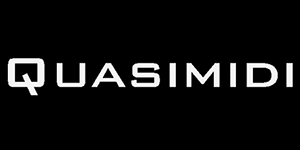
Quasimidi Musikelektronik GmbH is a German synthesizer manufacturer founded by Friedhelm Haas and Jörg Reichstein in 1987 in Kirchhain which later moved to Rauschenberg in 1988. The company ceased production in 2000.
Synth making began with MIDI devices and Quasimidi Styledrive which could store and play MIDI sequences and system control codes back. The company has also produced upgrade-kits to enhance the capabilities of some Roland synthesizers including Roland E-20 keyboard, as well as ROM cards.
Soon they became known thanks to their own synthesizers designed first of all for the dance music market. The first popular product was the digital rackmount Quasar modular synthesizer (1993) with a distinctive rough techno sound, an arpeggiator which could be recorded by an external MIDI sequencer.
Quasimidi Rave-O-Lution 309 groovebox was released in 1997 and even competed with Roland MC-303. Its architecture comprised a rather advanced sequencer and two quality sections of percussion and bass sounds. 309 is intuitive and allows you to record in real time and play any line and turn. The unit has a 5-part multitimbrality (kick, snare, hi-hat, percussion and bass). Controls make it very easy to adjust the volume, voices mix or isolation, as well as the filter and envelope modulation. Rave-O-Lution was quite an appropriate machine for the rave era.
In 1998 the new keyboard by the German brand – Sirius – appeared. Basically it followed the principles of 309. Most of its controls are assigned to patch editing. The instrument included a vocoder. 8 knobs were responsible for such settings as level, panning, FX; Sirius offered a selection of categories, such as "bass", "distorted bass", "atmospheric sounds", 808, 909, etc. Memory offers 96 patches, sequencer - 7 tracks (taken from Rave-O-Lution 309).
Quasimidi Raven was released a bit earlier again entirely dedicated to pulsating dance music and modeled as 309 in enclosed with a professional keyboard. The synthesizer generates bass, mono-synth, atmospheric, natural sounds, organ, FM percussion, effects, percussion, tuned percussion and multitimbral performance patches. You’re free to control an 8-track sequencer, arpeggiators and parameters in real time. Raven can be updated with a RavenMAX card which adds memory and more new sounds. Raven might remind you a bit of Roland JX-305.
Quasimidi built Cyber 6 – a 61-note keyboard with aftertouch allowing you to control 32 independent MIDI channels thanks to 2 MIDI outputs placed on the rear panel. The keyboard could be split into zones, each of which could go to its own assigned MIDI channel or be transposed thus allowing you to create wide palette of voices using various sound sources and building thick layers within a certain zone of the keyboard. The synthesizer had a Raven-like 8-track sequencer and rather complicated arpeggiator (due to 2 Motivators with numerous rhythmic patterns).
The last product released by the company was Polymorph, a virtual analog, which appeared to be an improved model of Rave-O-Lution 309. It comprised 4 synth-sections full of synthesizer sounds and percussion. Individual ADSR and filters per each oscillator made the synthesizer flexible and responsive. There is a built-in 16-step sequencer. The instrument voices can be muted or altered in real time to compose and rebuild grooves or sound textures. It also allows you to fashion and sculpt something out of pre-installed patterns in your own way. In addition to impressive sounds it has a number of effects: distortion, EQ, reverb, chorus, flanger, etc. per each part (4-part multitimbral). Orbital, J.-M. Jarre, the Prodigy used to have the unit in their arsenal.
During its short existence Quasimidi brand has become quite popular among the target audience of the 90s.

